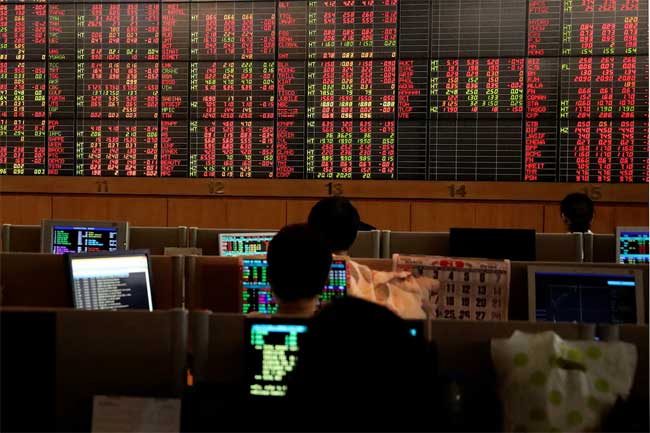
Section 1: Overview of Asian Markets and Their Current State
Asian markets are experiencing sharp declines due to escalating trade tensions. Major indices like the Shanghai Composite, Nikkei 225, and KOSPI have dropped significantly. For example, the Shanghai Composite fell by 3.5% in a single day, while the Nikkei 225 lost 2.8%. These declines reflect investor concerns over the impact of U.S. tariffs on key sectors like automotive, electronics, and manufacturing.
Foreign investors are pulling out of Asian markets, leading to capital flight. This has caused a loss of over $200 billion in market value across the region since the tariff announcements. Consumer confidence in countries like China and Japan is also weakening, as households brace for higher prices and slower economic growth. Smaller economies, such as Vietnam and Thailand, which rely heavily on exports to the U.S., are particularly vulnerable.
Central banks in Asia are taking steps to stabilize markets. For instance, the People’s Bank of China has injected liquidity into the financial system, while Japan’s central bank is considering further monetary easing. However, these measures may not be enough to offset the broader economic impact of the tariffs.
Section 2: Analysis of Trump’s Tariff Policies and Their Impact
The Trump administration has imposed tariffs on a wide range of goods, including steel, aluminum, and electronics. These tariffs target countries like China, Japan, and South Korea, citing national security concerns and the need to reduce the U.S. trade deficit. In response, affected countries have announced retaliatory tariffs on U.S. goods, such as agricultural products and automobiles.
Economic models predict that these tariffs could reduce global GDP growth by 0.5% over the next year. Companies are already adjusting their supply chains. For example, some electronics manufacturers are moving production from China to Southeast Asia to avoid tariffs. The risk of a full-blown trade war is increasing, which could further disrupt global trade and harm Asian economies.
The World Trade Organization (WTO) is struggling to mediate these disputes. Its ability to enforce trade rules is being tested as countries take unilateral actions. This uncertainty is adding to the volatility in Asian markets.
Section 3: Geopolitical Context and Its Influence on Markets
Recent geopolitical events are compounding the challenges for Asian markets. Israeli strikes on Gaza, which killed 32 people, and claims by Yemen’s Houthis about U.S. strikes have heightened tensions in the Middle East. These events increase uncertainty and can lead to higher oil prices, which negatively impact Asian economies that rely on energy imports.
Historically, geopolitical crises have caused sharp declines in Asian markets. For example, the 2014 conflict in Ukraine led to a 5% drop in the Nikkei 225. Political leaders’ statements also play a role in shaping market sentiment. For instance, President Trump’s tweets about trade policies often cause immediate market reactions.
Diplomatic efforts to de-escalate tensions are crucial for stabilizing markets. However, the current geopolitical climate makes this difficult. Investors and businesses must carefully manage geopolitical risks to protect their interests in Asia.
Section 4: Economic Indicators and Market Sentiment
Key economic indicators in Asia are showing signs of strain. GDP growth in China has slowed to 6.2%, its lowest rate in decades, while Japan’s inflation remains below target. The tariffs are expected to further dampen economic growth across the region.
Consumer and business confidence surveys reveal growing pessimism. In China, consumer confidence dropped by 10 points in the last quarter, while business confidence in Japan fell to a three-year low. Market sentiment is driving short-term volatility, with fears of an economic downturn becoming self-fulfilling.
Currency fluctuations are another concern. Asian currencies, such as the Chinese yuan and South Korean won, have weakened against the U.S. dollar, making imports more expensive. Commodity prices, especially oil, are also affecting Asian economies. Higher oil prices increase production costs and reduce consumer spending power.
Section 5: Future Outlook and Potential Scenarios
The future of Asian markets depends on how the tariff disputes are resolved. Possible scenarios include diplomatic negotiations, new trade agreements, or further unilateral actions. Each scenario has different implications for the region.
Experts predict that Asian markets could recover if trade tensions ease. However, prolonged disputes could lead to a prolonged slowdown. Technological advancements and innovation may help mitigate some of the negative effects. For example, automation could reduce production costs and offset tariff impacts.
Regional cooperation within Asia is also important. Trade agreements like the Regional Comprehensive Economic Partnership (RCEP) could help counterbalance the effects of U.S. tariffs. Long-term strategic planning is essential for businesses and investors to navigate the current environment.
The global economic power dynamics may shift as a result of these challenges. Alternative economic blocs, such as the European Union or ASEAN, could gain influence, reducing reliance on the U.S. market.



